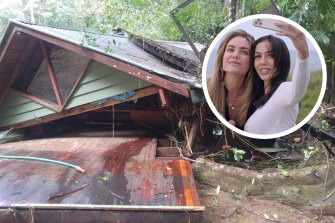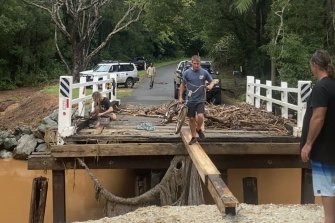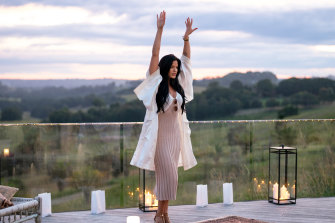By Jessie Cole

Jessie Cole’s family cabin, destroyed by floods in 2017, and the cast of Byron Baes.
All stories, even true ones, are constructed – some events highlighted, some ignored. Reality television, despite its name, is one of the more constructed forms of entertainment. Characters and storylines created by manipulative editing; drama manufactured where it may not have existed. Byron Baes, a new Netflix reality “docusoap”, is out and I’ve been thinking about how it really feels to live in the Northern Rivers. Cue endless rain.
I have lived here, in the hinterland, all of my life. Seasonal flooding is normal. The creeks rise, covering low causeways, trapping some of us in. After the rain stops, the creeks fall, and those trapped in can get out again. As a child, this flooding was always exciting. My family didn’t get flooded in, but if the creeks surrounding us rose to a particular height, we were allowed a day off school. My father would take us for a drive to the shops. On the way, we would cross three bridges, the dark orange water rushing below. At the shops, he would buy us Kool Mints, the only time we were ever allowed sweets. For years, I associated flooding with the intense burst of a Kool Mint in my mouth, oh the joy!
Five years ago, there was rain like we had never seen before. My family lost a cabin on our property to the raging torrents, its stumps sucked from the earth, the whole cabin lifted and smashed up downstream. The road in front of our closest bridge washed away completely and we were trapped in for days with no power, no running water, no landlines, no reception. Lismore and Murwillumbah were decimated. They told us it was a one-in-100-year-flood.

Jessie Cole’s neighbours carrying bikes over a destroyed road so they can get to the nearest town during the latest crisis.
Two and a half years later we were in a drought so severe our rainforests burned. We evacuated due to the threat of fire, a threat we had never experienced before. My house didn’t burn, but others did. Suddenly, we found ourselves caught in this new rapid cycling extreme weather, pinging from one disaster to the next.
During the pandemic, a huge wave of urban migrants hit us, a sea/tree change of epic proportions. Real estate prices rose wildly, renting a house became near impossible. Single mothers with small children shifted quietly into friends’ garages. People who had previously had homes started sleeping in their cars. It was not uncommon to walk into a public toilet and stumble upon an embarrassed middle-aged woman giving herself a quick sponge bath by the sink. This is the story of gentrification the world over, but in the Northern Rivers we were also post catastrophic flood and catastrophic fire. A traumatised community, trying not to buckle under the weight of the next influx.

Elle Watson in Byron Baes.Credit:Paul A. Broben/Netflix
And here we are. This new flood, only five years after the last one, but, according to NSW Premier Dominic Perrottet a one-in-1000-year event. Unlike the 2017 flood, where the rain fell all on one terrifying night, this rain continued for days. Our bridges went down, and we were, once again, flooded in with no power, water, reception or landlines.
The roar of the creek below my house was so loud that it drowned out even the sound of the driving rain. In the blackness of night, I couldn’t even tell when the rain stopped or started. I lay awake, nostrils filled with the rising smell of mud, imagining landslides, imagining my house being washed away, imagining the trees in the forest around me falling.

Netflix’s Byron Baes presents a very different story to that experienced by many of the region’s locals. Credit:Netflix
But I was lucky. All this happened in neighbouring gullies, not mine – in Kurrajong, the longstanding multiple occupancy just down the road, in other nearby mountain towns. Upper Main Arm, Palmwoods, Upper Wilson’s Creek, Huonbrook, Wanganui, Byrrill Creek, Uki and more. Landslides so monumental they took out whole houses and roads and forests.
I heard from friends who live in there that the crack and rumble of the land giving way was so unfathomably loud that people ran in terror straight into the rain, all concept of shelter upended. Lismore and Mullumbimby and Murwillumbah, and almost all our larger suburban townships, were, once again, swallowed whole by rising rivers. In this new normal, both our lowlands and highlands have become potentially uninhabitable.
When I was given access to the previews of Byron Baes, I had no electricity to watch them. When the power finally came back on, after days of cleaning up mud and digging new drainage trenches, I logged in to have a look. It was everything I expected. That is to say, there was nothing of reality reflected in this reality television. All stories are constructed, parts of reality highlighted, parts erased. I thought about my homeland, this sudden epicentre of climate change disaster, a bunch of small towns full of rough-around people, so many devastated and in need, mud-splattered and dead tired but still helping each other, our real stories, our real lives, always just out of view.
Most Viewed in Culture
https://news.google.com/__i/rss/rd/articles/CBMic2h0dHBzOi8vd3d3LnNtaC5jb20uYXUvY3VsdHVyZS90di1hbmQtcmFkaW8vdGhlaXItYnlyb24tYmFlcy1pcy12ZXJ5LWRpZmZlcmVudC10by1teS1ieXJvbi1iYXktMjAyMjAzMDctcDVhMmZlLmh0bWzSAQA?oc=5
2022-03-09 18:30:00Z
1329439026
Tidak ada komentar:
Posting Komentar